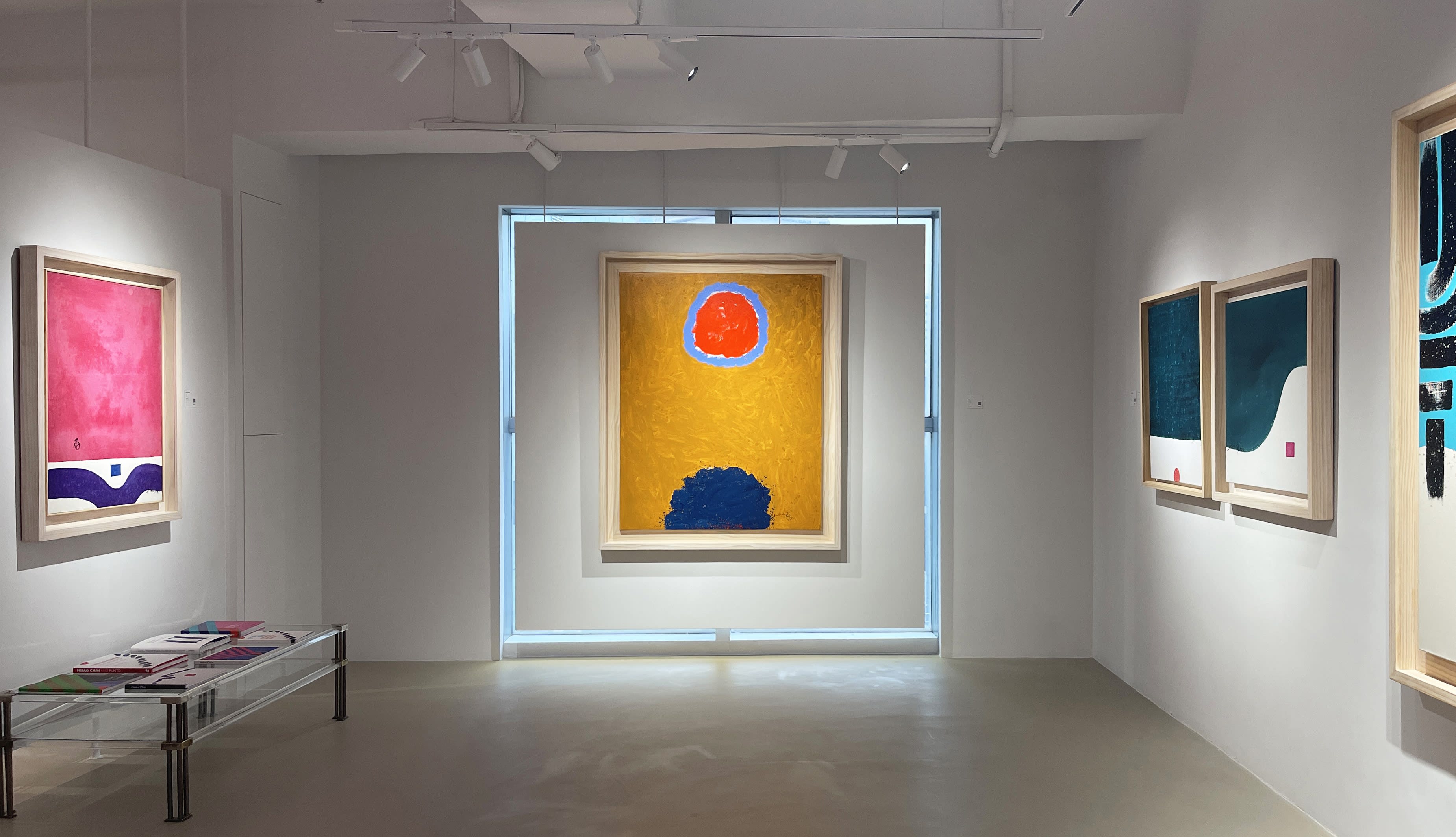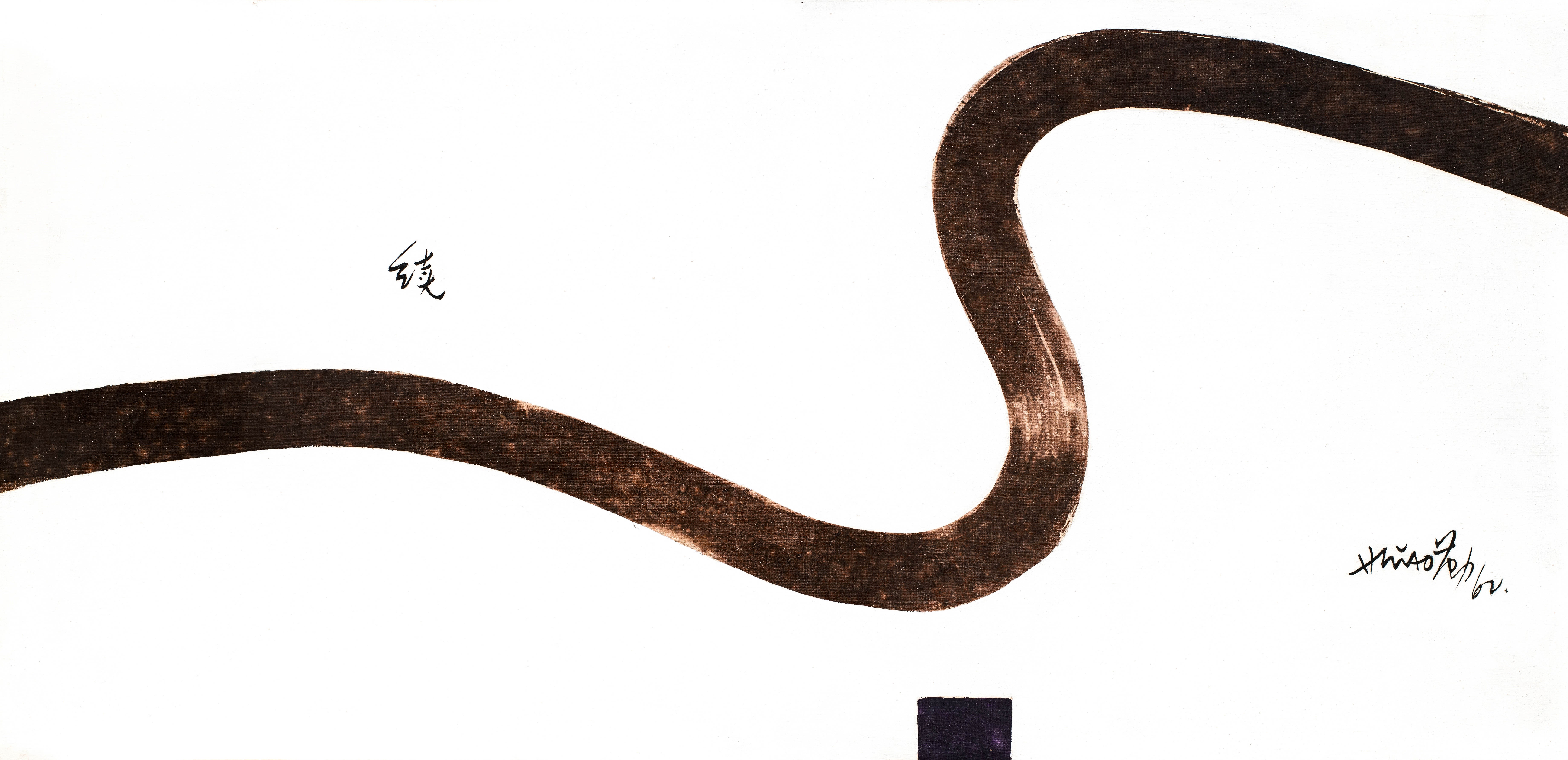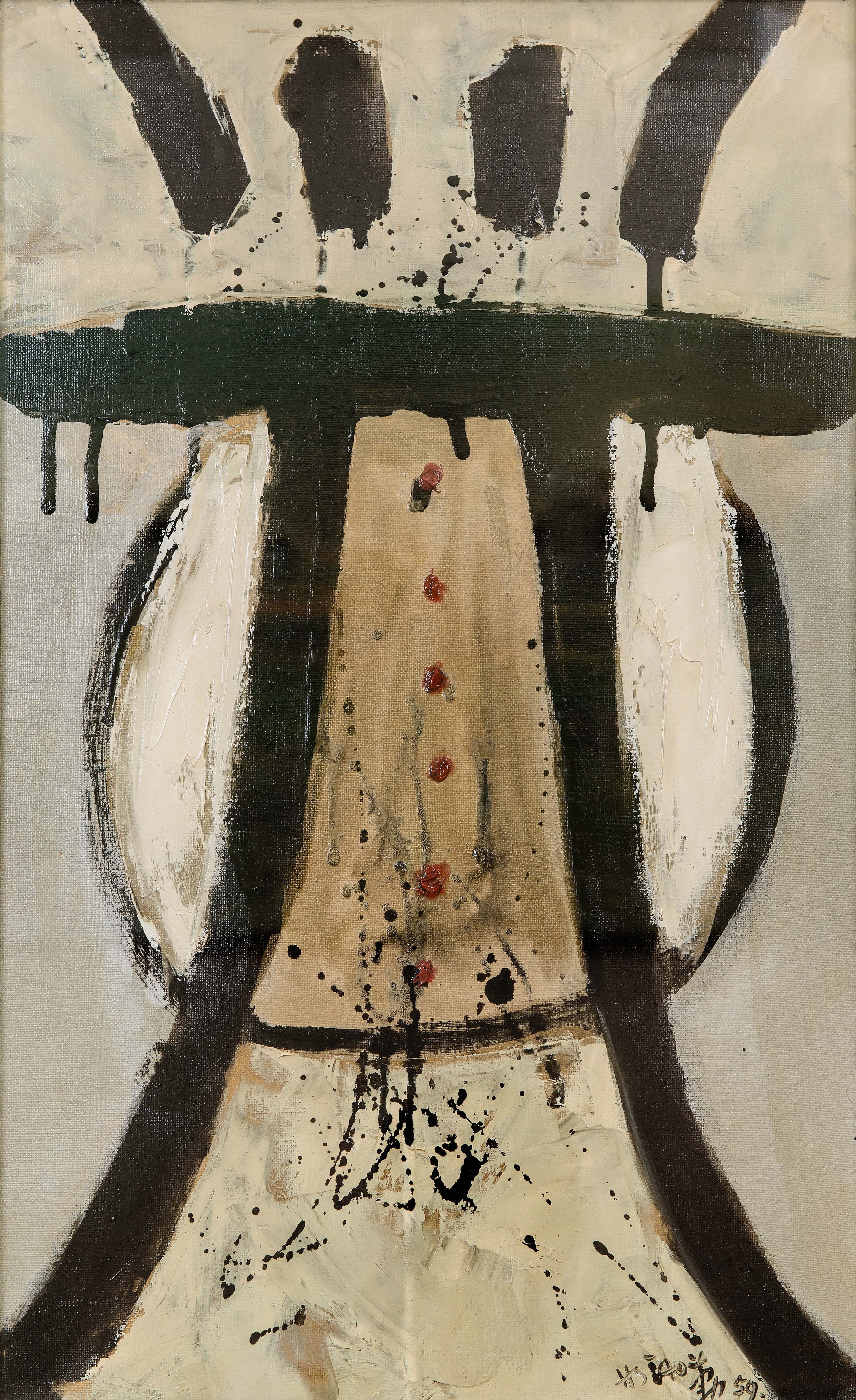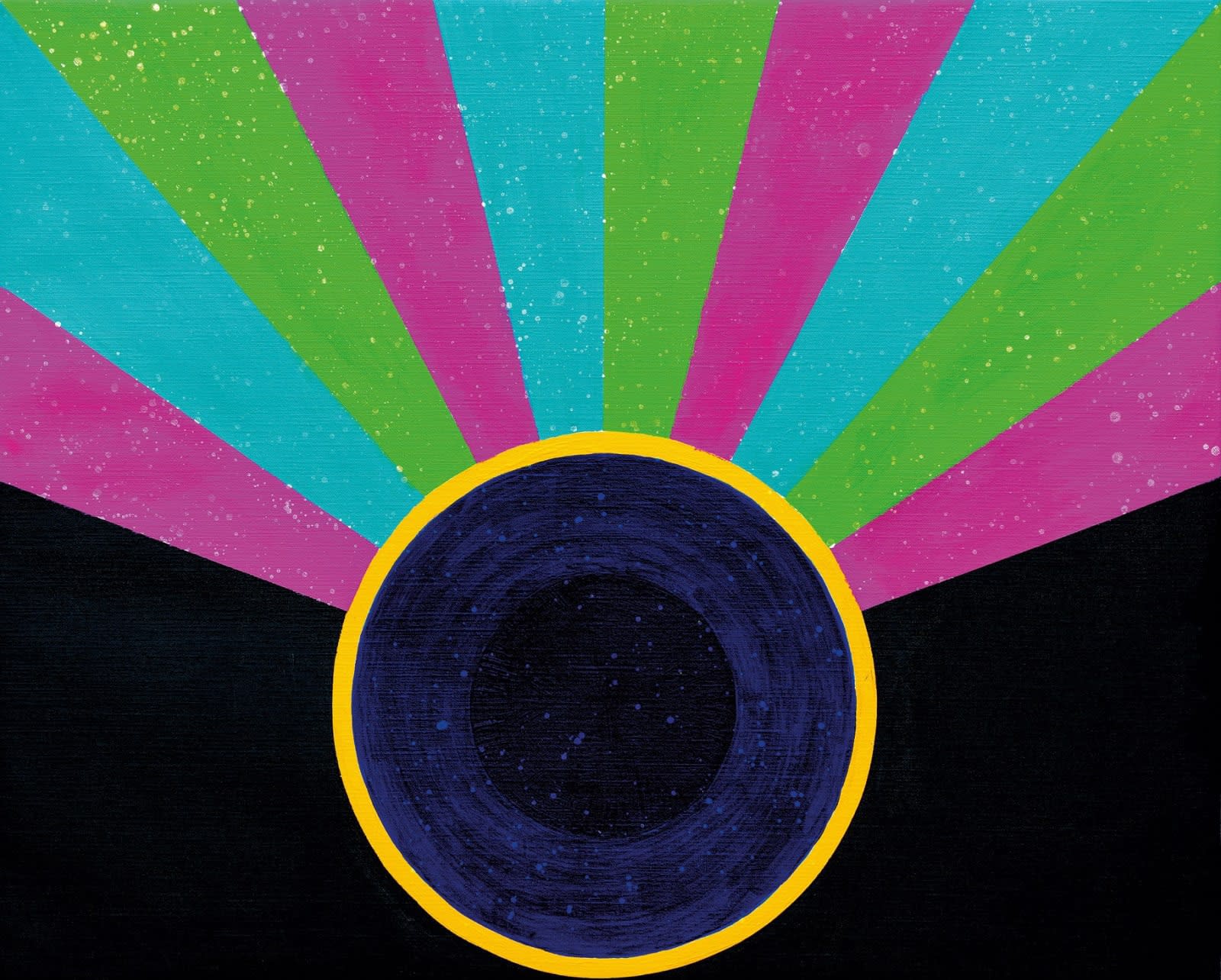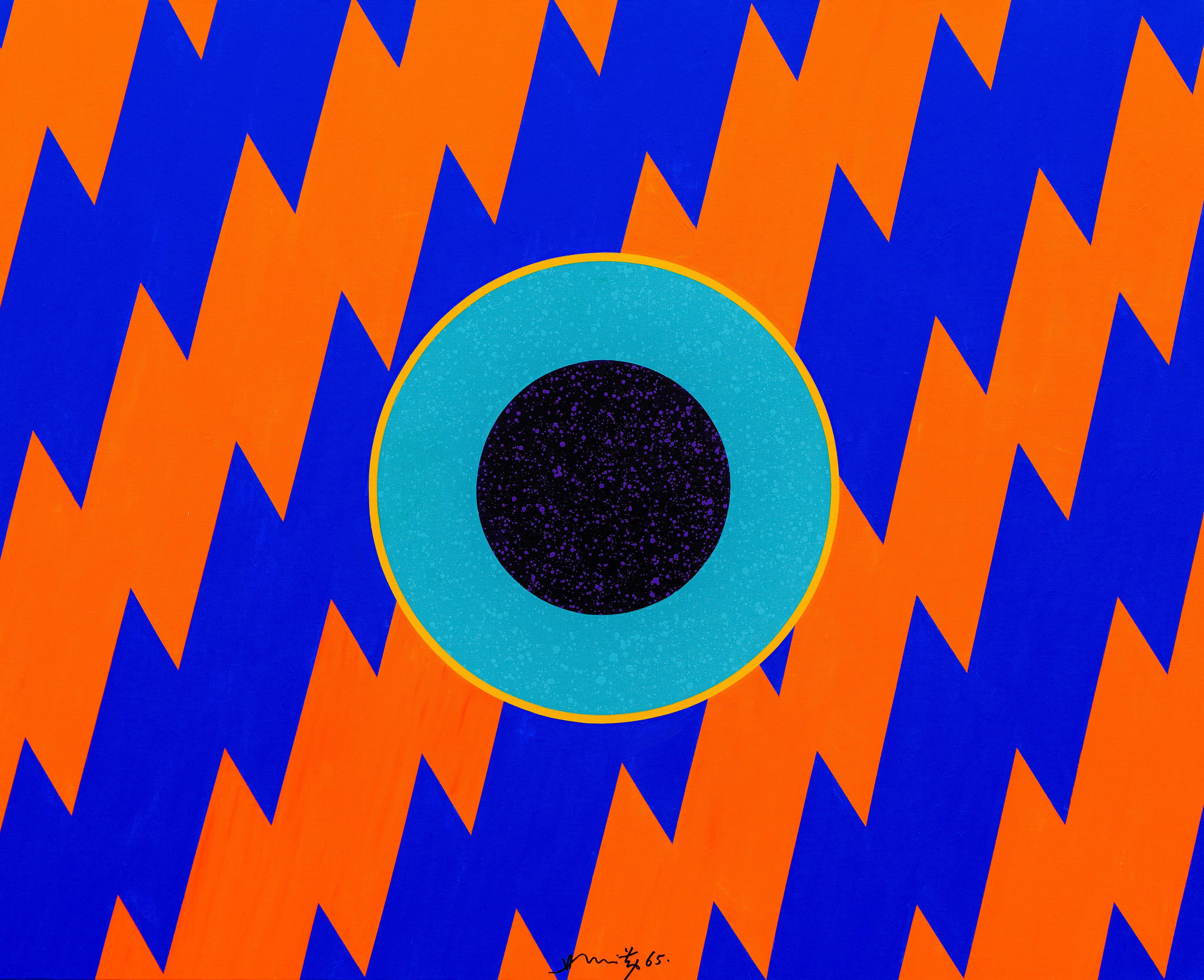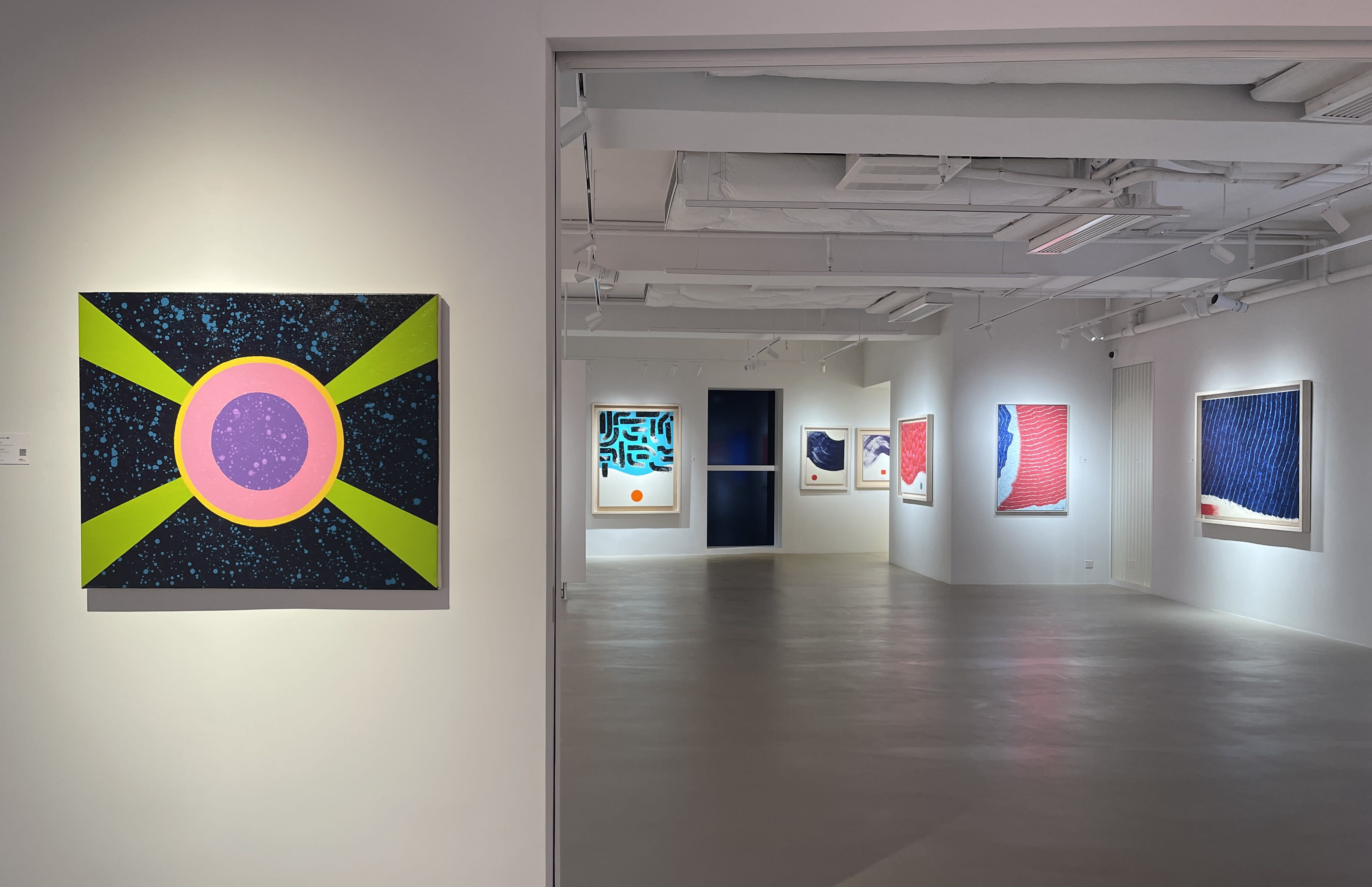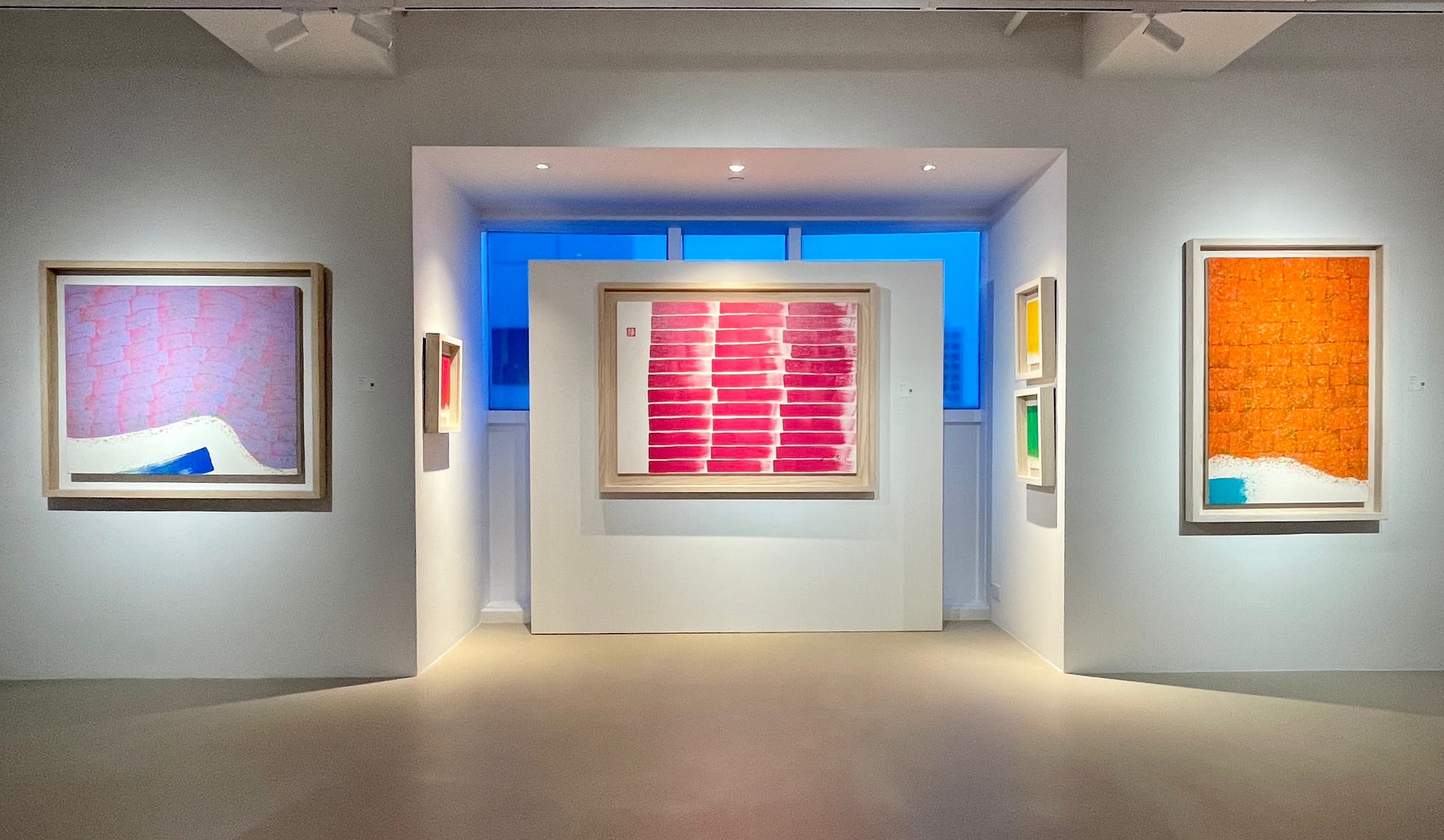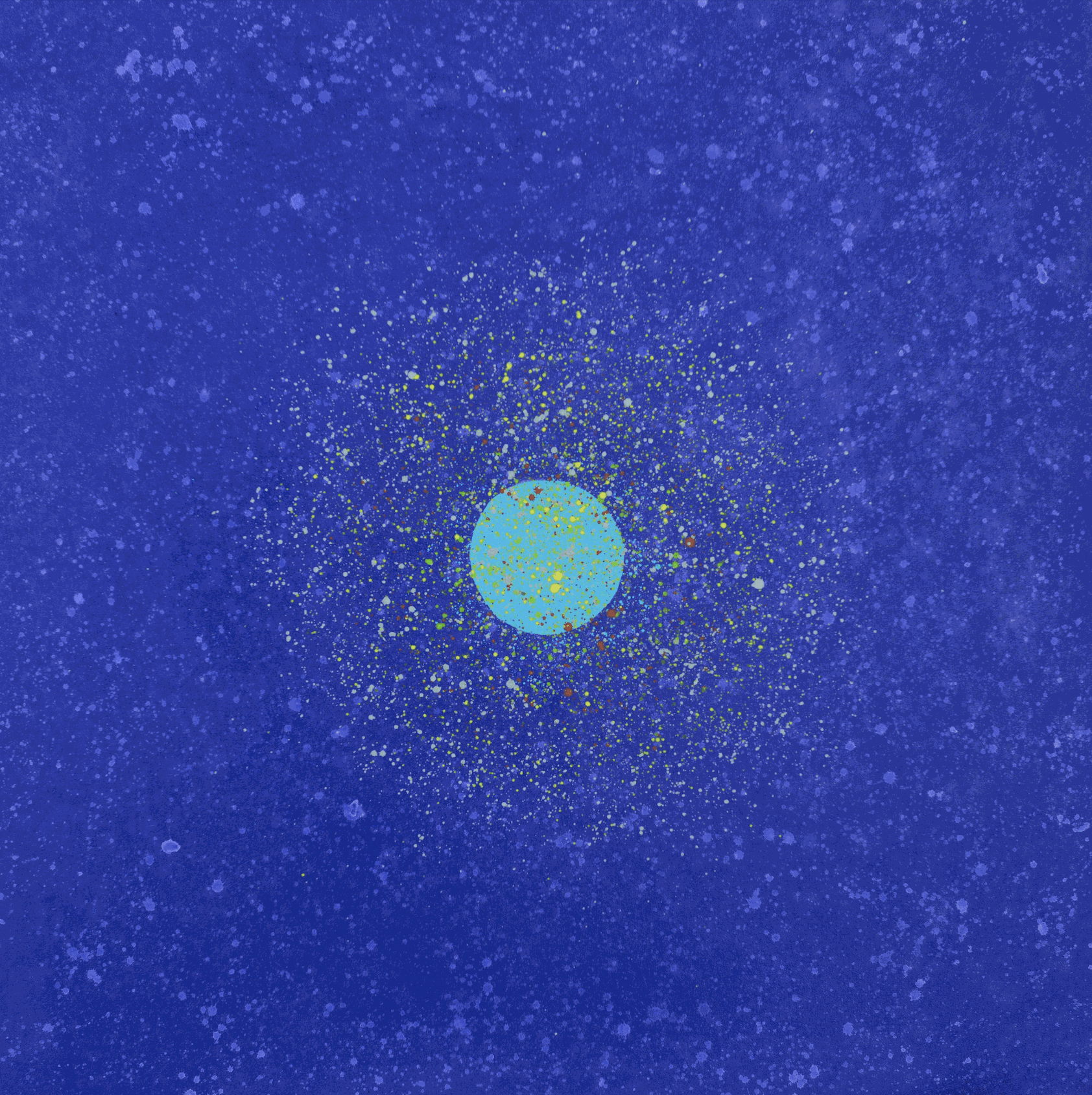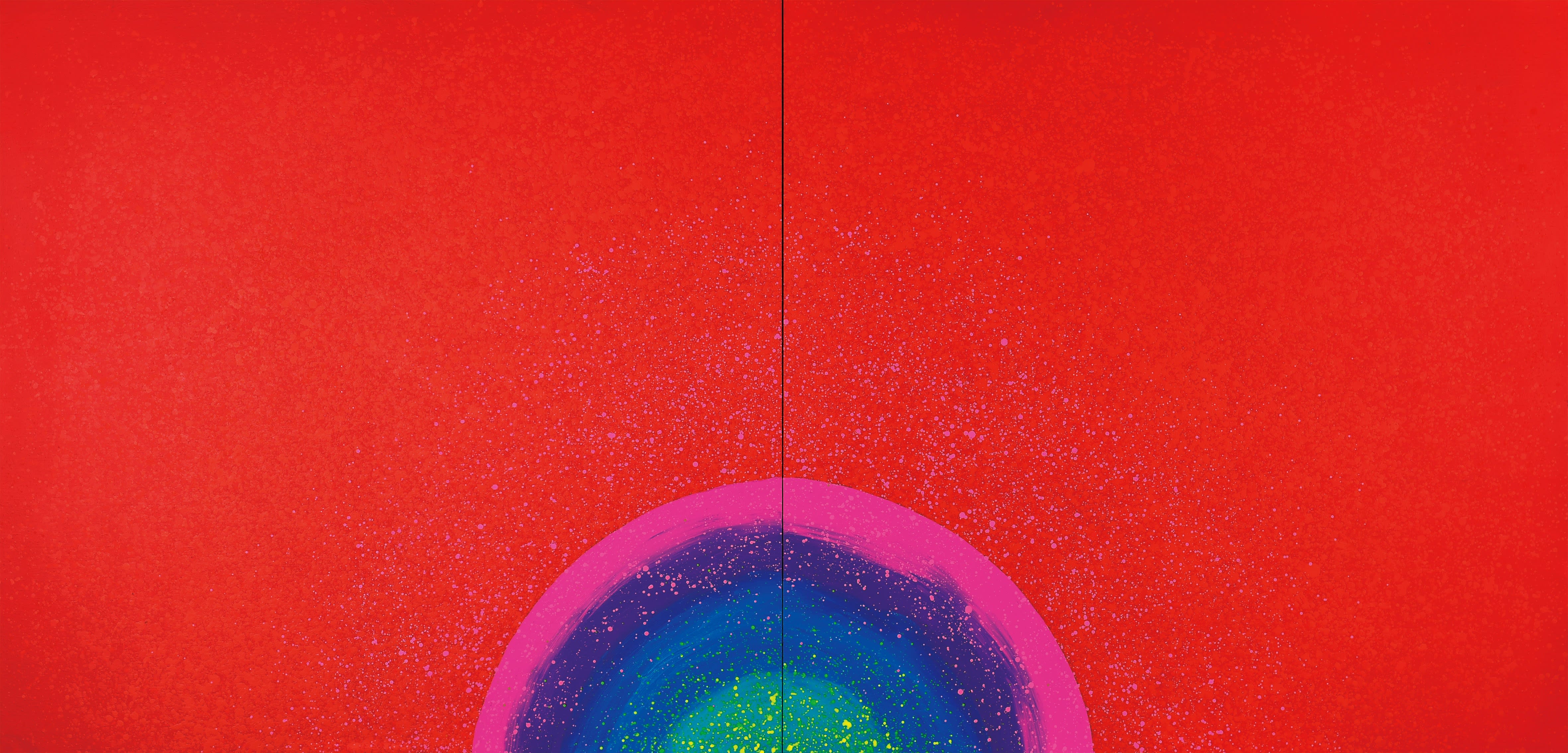
For me, the utmost important thing about painting is not the act of painting itself, but to explore the origin of one's life, to record one's feelings and experiences and to envision one's future through the act of art-making.
Hsiao Chin, 1978
Hsiao Chin: His Unexplored History, 3812 Gallery Hong Kong, March 2023
(left to right) Retain 1961, Discover 1961, Il Silenzio 1962, La Forza 1962 & Dancing Light 15, 1963
NB: HSIAO CHIN IS NOW 88 YEARS OLD. THIS ESSAY, WRITTEN BY TSAI CHAO-YI, WAS FIRST PUBLISHED IN THE CATALOGUE OF HSIAO'S RETROSPECTIVE EXHIBITION EIGHTY YEARS OF ENERGY, HELD AT NATIONAL TAIWAN MUSEUM OF FINE ARTS, TAICHUNG, IN 2015 - 2016.
In an interview nearly 40 years ago, Hsiao Chin talked about his attitude on painting and life. Now approaching 80 years of age and at the summit of his life and artistic achievements, the artist remains at the same level of intellectual and creative vibrancy as he once again makes a profound statement about art and life with Eighty Years of Energy as the title for his retrospective exhibition. In a convincing, decisive and ambitious manner, Hsiao Chin declares his continued passion and commitment for art which he has no plans of slowing down.
Looking at the longer span of Hsiao Chin's life, we need not be surprised that Hsiao Chin's whole life is defined by the pursuit of the meaning of life through endless learning. Central to Hsiao's subtle yet critical enquiry through his abstract painting is to advance the depth and scale of his life experience, and to interpret and explore the deeper meaning of life through the act of art-making.
Hsiao Chin, Continuity, 1962, Acrylic and ink on canvas, 48 x 100 cm
Born in 1935, Hsiao Chin co-founded modern painting group Ton-Fan Art Group in 1956, and is one of the "Eight Pioneers" of the association. He is also a leading figure of Taiwan's first-wave modern art movement in the 1950s. Amid a time of hope for revolutionary changes, Hsiao broke away from the conservatism of the art academy and traditional painting styles to embark on a journey of self-discovery through art. He has been living abroad for 60 years, but has always looked back on his Eastern cultural roots for artistic inspiration while at the same time also incorporated the reflexive, dialectic of the Western critical tradition to develop a unique artistic perspective and creative vision. The unique feature of Hsiao Chin's art is the accumulation of his 60-year-long artistic journey which has seen the evolution of artistic styles, his dialectical vision of modern painting and his topological view of artistic form. His strong personal style in abstract painting owes a great deal to Eastern aesthetics and helps him win recognition and praises from the Western art world.

Members of the Ton-Fan Art Group with Li Chun-shan
Hsiao Chin had left Taiwan for Spain prior to the founding of Ton-Fan Art Group (1956) and its opening exhibition (1957). In 1957, Hsiao began to write articles for the European Newsletter forum of the United Daily and continued to do so for the next two years. He also published articles that introduced the concepts and developments of the avant-garde in Wen-Hsing Monthly and other print media, and in so doing opened a window for Taiwanese readers to gain insights into the history and development of European arts. In the late 1950s and the 1960s, Hsiao Chin played a groundbreaking role in promoting interaction and exchange of Taiwanese and Western fine arts through exhibitions. Observing from the centers of European art world, Hsiao Chin has developed a broad and diversified vision of culture and arts. As an artist, Hsiao never ceases to look back on Eastern cultures that have shaped his artistic identity.

Pintura 5, 1958, Oil on canvas, 50 x 60 cm
In 1957, Hsiao Chin, along with fellow members of Ton-Fan Art Group, participated in the first Ton-Fan Art Group Exhibition upon the founding of this modern painting society. In this exhibition, the artists upheld the core concept that "all the national and geographical boundaries between art forms will eventually collapsed due to frequent exchange between various cultures of the world. Nevertheless, the essential spirit of each culture can still provide a strong foundation for new types of art-making." With this manifesto, members of Ton-Fan Art Group demonstrated their strong desire to return to their cultural roots while at the same time to develop innovative art forms, as they emphasized that the kind of modern painting they practiced was a new art form which grew from the soil of national culture, but appealed to global audiences. Although they were motivated mostly by Western abstract art, Hsiao Chin and his fellow Ton-Fan members were ambitious in developing their abstract painting brand which would be distinguished from Western abstract art. They looked upon Eastern cultural traditions both ancient and modern in their quest for personal styles and artistic vocabulary.
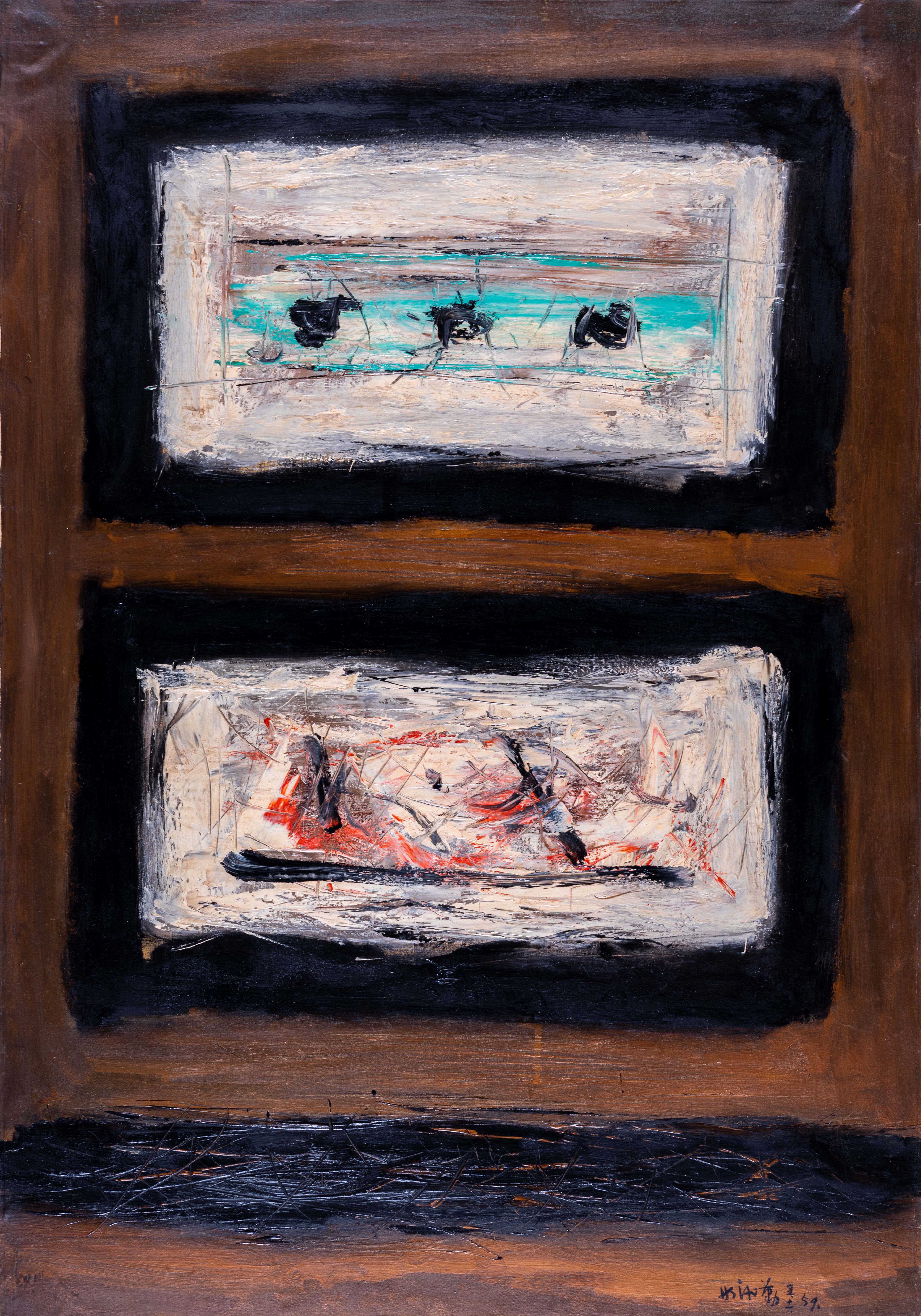
Painting-BR, 1959, Oil on canvas, 100 x 70 cm

Hsiao Chin: His Unexplored History, 3812 Gallery Hong Kong, 2023
(left to right) Pittura CB 1959, Painting BR 1959, Pittura BM 1959 & Pintura DK 1959.
Launched by Ton-Fan Art Group and another significant association, the Fifth Moon Art Group, this new wave of modern art movement is significant in the development of Taiwan Fine Arts in a number of ways. The anti-establishment attitude of these artists and their quest for innovation resulted in the awakening of cultural self-identification. Informed by Eastern cultural resources, their artistic experiments have led them to develop a set of aesthetic principles which differed from those that had governed Western abstract art traditions. Their emphasis on returning to one's own cultural roots in the spirit and cultural configurations in the content is an essentially Taiwanese experience as far as the modern art movement is concerned. Their experiments on the art form led them further into exploration of new mediums and techniques. With burning enthusiasm, these artists promoted the ideals and concepts of the art group. Consequently, heated debates between the Oriental and Occidental cultures broke out amid their tug of wars between the modern and the traditional, the innovative and the conservative, opening up further debates on the essence of art-making. Such debates also marked the first attempts made by Taiwanese artists to define the unique features of Taiwanese art.
To understand Hsiao Chin's creative and spiritual journey, one needs to place his artistic experiences in the context of the overall milieu of Taiwanese society in which the artist lives and practices art, as well as the artist's own subjective views on art-making, with special attention to how the artist sees himself and his personal styles, or how, while living and practicing art abroad, Hsiao Chin re-oriented his artistic approach in the cosmopolitan centers of European arts and cultures. More specifically, one should enquire into why the artist from the Far East, having been through the direct experience of interacting with Western cultures, returned to Eastern cultures and philosophies for artistic inspiration, and how he has actualized the Oriental cultural traditions in art practice. One needs also look at how Hsiao Chin has responded to changes in the exterior environments and setbacks in personal life with a unique set of artistic vocabulary which reflects both his cultural heritage as well as personal experience. This essay looks at the inter-relations between Hsiao Chin's personal experiences and the evolution of his artistic styles, exploring how he has achieved greatness of his art through topological mapping of the meaning of life.
Pintura-DK, 1959, Oil on canvas, 61 x 37 cm
The Point of origin: towards self-discovery
Hsiao Chin took up formal artistic training in 1951, and in the following year started taking lessons from Lee Chun-shan, whose maxim was "to think with your mind, to feel with your heart, to observe with your eyes, and to finally deliver with your hands". Lee encouraged students to explore their inner perception and to find and develop their own unique voice in art-making. This teaching style has helped Hsiao Chin gain self-awareness and set him on the path to self-discovery in the early stage of his art practice. His works of the 1950s covered a wide range of genres, themes and styles including, to name but a few, figurative portraiture, pictogram, Mandarin opera characters and abstract ink-painting. Characterized by the handcrafted feel of the lines, creative use of colors, transformation of forms, intuitive yet emotion-filled quality, all these work show Hsiao Chin's anti-establishment approach to art in that he made a brave attempt to walk away from the traditional teaching style of the art academy which had remained faithful to conservative painting styles and realist techniques, and instead to embark on a multifaceted exploration of the avant-garde.

The Beginning of Tao-6 (L_Inizio Del Tao-6), 1962, Acrylic and ink on canvas, 80 x 60cm
Looking at Hsiao Chin's six-decade long artistic career from a meta-analytical point of view, we can see that many of his signature style elements can be identified even from his early works, such as an emphasis on intuition and introspection, strong and vibrant colors, symmetric bilinear forms, use of varied lines, a strong sense of rhythm in the composition as well as uses of symbols and symbolism. Under the guidance of Lee Chun-shan, who encouraged his pupils to draw artistic nourishment from traditional Chinese culture, Hsiao's early works can be seen inspired and influenced by traditional Oriental art forms such as Buddhist statues, Chinese calligraphy, traditional ink painting, as well as the costumes of Chinese opera and folk arts. In 1957, Hsiao began to experiment on incorporating the lines and compositions of Chinese calligraphy in abstract painting, as he created images which blended together metaphorical and emotional content of expression. In 1958, Hsiao Chin began trying to shift from direct expression of emotion to a lyrical and contemplative mode of expression which can be seen articulated through symmetrical picture composition.
TOPOLOGY OF EASTERN AESTHETICS:
REFLECTION, EXPLORATION AND EXPERIMENTATION
Hsiao Chin: His Unexplored History, 3812 Gallery Hong Kong, 2023
(from left to right) Il Silenzio, 1962, La Forza, 1962, and Dancing Light 15, 1963
Hsiao Chin developed an interest in Zen and Taoism and especially the ideas of Lao Tzu and Chuang Tzu around the 1960's, drawing inspiration from these eastern philosophies for his abstract painting. As he broadened his interests to other fields such as the science of the outer space, the planets and the universe, Hsiao began to try to combine his understanding of such knowledge with his studies of Tibetan Buddhism, Indian Mandala painting and thankga art in his work. Hsiao's works from the years between 1960 and 1966 often highlight the contrast and harmonious balance between dichotomous elements, featuring the sun and other radiating objects and the rhythms of lights.
Purple Sun (Il sole viola), 1964, Acrylic on canvas, 80 x 100 cm
This period marked a crucial turning point in shaping the personal style and characteristics of Hsiao Chin's painting. Figurative aesthetic objects were replaced by complete abstraction, and the works were now focussed on the spirituality of art practice. During this period, Hsiao Chin made the quest for Eastern spirituality and modern artistic expression his main artistic mission, and realized these ideals through establishing a strong personal style in his abstract paintings.
Hsiao Chin's solo exhibition at the Galerie Internationale Art Contemporain in Paris, 1964
Hsiao Chin once recalled his parents and his upbringing, which he called "a mixture of humanism and mysticism". The liberal-humanism of his father and the Christian faith of his mother played a key role in shaping his early creative development:
On the one hand, I am rather philosophical, empirical and philosophical on the conscious level, one the other hand, I am inclined to the spiritualism, mythicism and synthetism of Oriental religions. I seem to be born with such dichotomous thinking; ever since childhood I began to develop skepticism about my own life and the need for soul searching.
Hsiao Chin, 1978
The Illusion of Sun-1, 1965, Acrylic on canvas, 130 x 160cm
Throughout his artistic life, Hsiao Chin's aesthetic sensibilities have been characterized by the dichotomous thinking, which can be seen manifested through the composition of the image, the symbols and symbolism as well as colors that together create a visual counterpoint that evokes dialogues, and adds to the work a subdued yet strong sense of intellectual depth. In this early stage, Hsiao Chin tended to resort to symbolism and topological experiments of art forms in his interpretation and representation of Oriental spirit. He shifted from impulsive expression of feeling to contemplation and introspection as he turned to Zen Buddism and the Taoism of Lao Tzu and Chuang Tzu for intellectual sustenance. Hsiao Chin drew inspiration from the cursive scripts of Chinese calligraphy that give rise to a sense of rhythm in art composition. The artist builds a metaphysical world with straight and curved lines, squares and cycles, black and white and the shades in between as well as penetrative black-leaving. The pieces in the Sun series, created from 1963 to 1966, convey the contemplative world of Mandala using the shape of a radiating sun in contrasting primary colors, with the symmetrical composition disrupted by acute angles that symbolize spiritual jolts and expansion of the fields of energy.

Radiation (La proiezione), 1965, Acrylic on canvas, 70 x 85cm
It is worth noting here that these years saw Hsiao Chin embark on dramatic shifts in all areas of art practice including his creative habits, approach, medium and expressive forms. Such changes can be seen to reflect a profound sense of nostalgia and anxiety as he was confronted with a environment and culture. On the other hand, however, Hsiao's topological exploration during this stage has also helped him build a strong foundation for his future art practice in a number of ways. First, in so doing, Hsiao Chin effectively embarked on a mission to advance his understanding of the dichotomous nature of the world, which he articulated through complex dialects between contrast and harmony, tension and balance, conflict and peace, the void and the solid, movement and immobility, Yin and Yang, strength and weakness as well as finite and infinity. Second, in his quest for balancing analytical and emotional appeal, Hsiao Chin challenged himself to more sophisticated use of colors and symbols which would enable translation of inner consciousness into metaphysical language that was to further inform his future art-making. Third, studying of Oriental cultures, philosophies and religions has enabled Hsiao to develop a humanistic and spiritual vision of Nature and the universe, and in so doing to set out the main focus of his future artistic pursuits which would be to develop a unique vocabulary of abstract painting from a broader cultural philosophical perspective.

Light of Hope, 1964, Acrylic on canvas, 200 x 130cm
Hsiao Chin The ninth exhibition of the Punto International Art Movement
at Gallerie Suzanne Bollag in Zurich, Switzerland in May, 1965
Hsiao Chin: His Unexplored History, 3812 Gallery Hong Kong, 2023
Intuitively minimal:
the Eastern-ness in the Hard Edge series
Hsiao Chin visited the United States for the first time in 1966, and moved to work and live in this country a year later. Feeling a strong impact of cultural shock in American industrial civilization, Hsiao Chin chose to reduce direct emotional expression in his work in pursuit of a state of meditation as he turned to a more calm, subdued, simple yet powerful style. The Hard Edge series, which Hsiao Chin developed in the years between 1967 and 1976, placed great emphasis on color contrast, often featuring directional cones with square or acute angles, or asymmetric shapes which give off a sense of position and movement. This period saw Hsiao Chin transforming the tumultuous, depressing experience of the external physical world into an inner reflection, as the artist tried to articulate, through experimenting with art forms, the juxtaposition of rationality and emotion, invasion and absorption, finite and infinity, Yin and Yang, motion and stillness, and the tension that arise from these binary opposites. Hsiao Chin calls this "intuitive expression of Eastern-ness", to be differentiated from the en vogue art styles of the United States at that time i.e. the Hard Edge, field art and minimal art which draw heavily on mathematically-based rationality.

The Hidden Secret , 1974, Acrylic on canvas, 70 x 90 cm
The drastic changes to Hsiao Chin's artistic style during this stage were a direct result of the artist feeling a sense of spiritual stagnation due to the lack of cultural-historical depth of American society. According to the artist himself, the Hard Edge series was "developed from a state of absolute solitude and absolute resolution which was the direct consequence of such solitude". This series is the hardest and sharpest set of works throughout Hsiao Chin's art career, placing great attention to precision in color and form as well as disciplines in the execution. As the artist has emphasized himself, the Hard Edge series was intended to construct "a symbolic space of the universe" which is also "a self-contained world of living things".
Poised to Roar, 1974, Acrylic on canvas, 80 x 100 cm
Swiss aestheticist and art critic Günter Schönenberger has once commented on Hsiao Chin's works of this period,
"His paintings are always always supported by a solid religious-philosophical foundation which allows him to achieve more than a simple mathematical structure. Most importantly, the works are characterized by harmony and balance between living creatures and the universe. Hsiao's paintings serve as a starting point from which to contemplate on the nature of modern life."
It should be noted here that albeit largely minimalist in design, Hsiao Chin's Hard Edge series was far from a field of emptiness. On the contrary, this series is a rigorously planned and constructed set of colors, forms and structures that reflect the artist's understanding of Eastern philosophies as well as the dichotomous nature of humanistic thoughts. With calm rationality, Hsiao Chin brings into this series his multi-layered perceptions of the reality. Inscribed in the rigor of the composition is an intuitive hunch communicated not through the rhythmic combinations of symbols as he used to do previously, but mostly through rigorous structuring of emotional expressivity that helps him achieve a well-balanced combination of intellectual and emotional depth, evoking imagination amid the dialectics of the art form.
Infinity of Chi:
phenomenon, essence and the world
In the 1970s, Hsiao Chin resumed his interests in Taoism and Zen and began studying Buddhism, hence re-discovered the subtlety and profundity of Eastern humanism. In the years between 1977 and 1990, Hsiao Chin created the Zen, the Chi and the Landscape of the Universe series, drawing inspiration from the invisible, unnamable yet omnipresent vitality which he calls the "power of energy and chi" as he looks back into the origin of the universe in his metaphysical and phenomenological contemplation. In these series, Hsiao Chin often creates dramatic grandeur with powerful brushwork to convey the flows of energy in the universe. Notably, he turns the blank-leaving into the main body of the painting to visualize the Great Vacuity and the what-is-not, making the invisible sea of chi a tangible aesthetic form. In so doing, Hsiao Chin observes the motion of the universe as well as changes of attributes of all objects from both the macro and the micro perspectives. To date, the "infinity of chi" has remained the main theme of Hsiao Chin's art practice. With a selfless state of mind, Hsiao Chin tries to achieve the art of Zen and Chi. By unforced exercise of brush strokes and intuitive exploration of color, the artist creates a spiritual space which communicates the movement and changes of the unnamable energies in the grand universe.

Chi- 315, 1984, Acrylic on canvas, 100 x 140 cm
What Hsiao Chin pursues is not personal enlightenment, but the creative connection between art and the state of Zen:
Zen has never taught me how to paint a picture. Despite misunderstanding on the part of others, I do not practice Zen art. As far as I am concerned, Zen makes me see my own inner mind with a clearer vision, allowing more freedom for me show the true self on the painting. Most importantly, it lets this pre-existing internal energies be the driving forces of the brush strokes and the colors without any constraints. It also makes me unite with my own inner strength.
Hsiao Chin, 1983
Hsiao Chin: His Unexplored History, 3812 Gallery Hong Kong, 2023
(from left to right) A Serene Journey, 1998, Chi-315, 1984, and The Bright Side-4, 1999
For Hsiao Chin, the power of Chi and energies signify the invisible, unnamable yet omnipresent vitality of the universe. Observing from the perspective of the natural law, Hsiao Chin's interpretation of Chi is to be comprehended in two equally important contexts. First, he approaches the essence of things by way of observing the phenomena of the external world, so that he could penetrate through the physical appearance of things to enquire into the relationship between the physical being and the world. The inner essence of art should go along with the flows of nature, but not limited by the external appearance of nature. Hsiao's Zen and Chi series both look through the spiritual core of the world through an intuitive and contemplative form of abstract expression. Second, Hsiao Chin also observes the external world from the point of view of the inner dimension. The Landscape of the Universe series features the artist's sentimental yet detailed observation of the nature. Many of the pieces under this series provide visual representations of certain concepts. The seemingly simple shapes intensify the emotional tension and spirituality of the painting.

Waterfall 15, 17, 21, 1988, Acrylic on canvas, 34 x 24 cm
Hsiao Chin observes the motion of the universe as well as changes of attributes of all objects from both the macro and the micro perspectives. The "state of Great Vacuity" in Hsiao's paintings is articulated in more than one way, and capable of evolving. We can feel, from some series such as The Magnetic Waves, The Showers, The Waterfalls and The Storm Wind series, the powerful vibration of the chi (i.e. the energies) in the infinite expanse of space and time. Works in The Black Clouds series and The Grand Volcanoes series feature bursts of energy erupting across the face of the planet. In The Whirpool of the Universe and The Galaxy series, we get to feel the vastness of the universe and the infinite spaces of the sky. From the 1990s onwards, Hsiao Chin has tried to express the "chi" in a variety of forms, which include also circles that open up from the centers in a radiating direction such as the whirlpool, endlessly expanding and shrinking, inhaling and exhaling in the vast space of the universe. For Hsiao Chin, there can be a million ways of painting. To date, the "infinity of chi" has remained the main theme of Hsiao Chin's art practice.
PASSAGE THROUGH THE GREAT THRESHOLD:
EXPLORING THE MEANING AND ETERNAL NATURE OF LIFE
La meditazione sul passaggio di grande soglia-4, 1997, Acrylic on canvas, 140 x 110 cm
In 1990, Hsiao Chin lost his daughter Samantha in a tragic accident. The sudden loss of his beloved daughter dealt Hsiao Chin a major emotional blow, and drove him to a deeper spiritual quest for self-healing and transcendence. During this period, Hsiao's paintings took a thematic shift from the heavenly bodies to the earth as the artist looked to explore deeper meaning of life. The works under the Samantha's Ascension and Passage through the Great Threshold series show the artist's quest for transcendence of mortal vision, which are rich in philosophical ideas of transmigration of the soul and religious ideas of redemption.
Once I have been through such heart-wrenching experience and understand the nature of it, it finally dawns on me that life is eternal and does not end with death. Rather, the seed of eternal life continues to grow on the brighter end of the Great Threshold.
Hsiao Chin
Hsiao Chin: His Unexplored History, 3812 Gallery Hong Kong, 2023
(left to right) Samadhi 54, 2000, La meditazione sul passaggio di grande soglia-4, 1997,
On the Eternal Garden - 15, 2000, On the Eternal Garden - 13, 2000
Passage through the Great Threshold, a testimony to a new perspective on life, illustrate Hsiao Chin's new take on life and death, as well as his optimistic outlook towards the future. As he translates his positive inner voice into aesthetic acts, Hsiao Chin employs color as the primary tool for creating a narrative of emotional experience. This series saw the artist trying on bright, vibrant colors and free-flowing lines that glow with the promise of a renewed spiritual life. Hsiao's idiosyncratic dichotomous thinking is visually articulated to show his philosophical view on the holistic inter-relationship and co-dependency between this and the other side of life. The image is divided by a strip of blank-leaving to create a sense of vastness. The vast expanses of colors give off a sense of rhythm that evokes poetic imagination of the infinite, as if all lives were completely liberated in the free open space and hence quietly extend their being into the world beyond this world, once they had passed the Great Threshold.
Passage through the Great Threshold marks a significant turning point in Hsiao Chin's creative views. Prior to this series, Hsiao's works have tended to engage in the metaphysical exploration of mysticism. From the 1990s onwards, his paintings were further focussed on dialogues of emotional and spiritual experiences. The Eternal Garden was one of the themes that Hsiao Chin has worked on with greatest depth and focus in the 1990s. It can be seen as an extension of the Passage through the Great Threshold series in terms of the aesthetic form. However, this series differs from the Passage through the Great Threshold in the sense that whereas the latter series portray an unknown and uncharted territory of one's life, the former envision a promised land with abundant vitality and energy - a place where the artist, having been through the most devastating tragedy, finds a profound sense of spiritual belonging. The thematic shift in Hsiao Chin's works can be seen to reflect on changes to his inner world.

Spiritual Reflection (Proiezione Spirituale-42) , 2000, Acrylic on canvas, 70 x 50 cm
As far as Hsiao Chin's artistic context is concerned, The Garden is not real in the physical sense; neither is it created out of imagination or illusion. It is rather more like a mirror onto which one projects subjective thoughts. Or, it can be likened to a mind field which contains an infinite amount of inner energy. At this stage of Hsiao Chin's life, the artist began to write a new chapter of life in a way that is both retrospective and prospective. Although his state of being remained unchanged, the artist began to engage in the dialect between the interior and the exterior of self amid a constant flux of boundary-crossing between the two. The Garden is the place where the artist finds inspirations and possibilities for contemplation, self-discovery and spiritual attainments. It is also open to all kinds of contingent existence, and especially to the grand energy of the universe in which Hsiao Chin has always placed great faith. In this sense, the Eternal Garden can be seen as a unique space of special importance. It connects the artist's inner world with the infinite and eternal space-time of the universe, and adds a human touch to an Eastern worldview which subscribes to the union of one's soul and the universe.

Samahdi-54, 2000, Acrylic on canvas, 90 x 110 cm
ETERNAL ENERGIES: HARMONIOUS COEXISTENCE OF ALL LIVES AND THE UNIVERSE
In many of his artist's statements made in or after 2000, Hsiao Chin has repeatedly emphasized the inspirational impact of the "grand energy of the universe" on his art practice. It should be noted, however, that the "grand energy of the universe" refers to not only the internal energies of the galaxies and planets. Hsiao Chin places even greater emphasis on the harmonious relationship between human lives and the universe, as well as the profound spiritual power that enables the persistence and coexistence of all lives, objects, cultures and religions with or without a tangible form. Hsiao Chin's works of this period often employ mature yet diverse vocabulary of forms as well as rich, strong cold and warm colors to express the profound meaning of being as he delves into the deep human consciousness and to praise the sacred yet intangible energy that drives the gears of the entire universe.
Hsiao Chin: His Unexplored History, 3812 Gallery Hong Kong, 2023
(left to right) The Bright Side-4, 1999 & Spiritual Reflection, 2000.
At this stage of life, Hsiao Chin can now grasp the essence of Tao, and especially its emphasis on tolerance and inclusion with comfort and ease. For decades, he has studied extensively on both Eastern and Western arts, philosophies, religions, mysticism and space science, all of which are now providing him with a solid intellectual foundation, helping him understand the full essence of the universe and the meaning of life itself. The spiritual warmth and poetic temperament that fills Hsiao's works owes a great deal to the artist's holistic approach to learning and life.
Chi-5, 2011, Acrylic on canvas, 130 x 130 cm
Although "chi" continues to take the center stage in Hsiao Chin's painting, the artist no longer paints with wild brush strokes, but instead slowly builds up the image by interweaving subdued yet delicate artistic contents and creating a dynamic between these formal elements. Blurring of binary opposites and mutual dependence of the two remains central to Hsiao Chin's idea of balance and harmony. As the clear boundaries between the binary opposites are dissolved, the energies - or Chi - would saturate the seemingly simple yet profound and penetrative work of art which beacons us to look at a colorful, vibrant yet mysterious world in which the feminine, gentle Yin coexists peacefully with the masculine, stern Yang. Through the artist's uniquely personally touch, the eternal life energy is thus given a new outlook in the work of Hsiao Chin.
CONCLUSION: ART-MAKING AS AN ENDLESS JOURNEY OF SELF-DISCOVERY
The changes and shifts in Hsiao Chin's creative style can be seen to provide a useful visual reference point of the cultures and thoughts that the artist has encountered in various stages of his life. It can be difficult to analyze Hsiao Chin's artistic ideas by examining one single concept alone, because behind the seemingly simple and minimalist pieces of abstract art is a complex system of ideas and ideals which is the product of fusing together Eastern philosophies, Western artistic forms and the artist's personal history. On the other hand, it would risk being imprecise and over-simplistic if one tries to comprehend the evolution of Hsiao Chin's artistic style from an overall perspective, because changes to any specific art style of Hsiao Chin is usually associated with changes to his other styles. It is particularly worth noting here, throughout his artistic journey, Hsiao Chin has tended to search for new inspiration by selectively repeating, or returning to, his previous art styles. Hsiao Chin's art never repeats itself and stands the test of challenges set out by the artist himself, largely because Hsiao is capable of turning an act of return into a new beginning. A retrospective review therefore becomes an important source of inspiration for future spiritual and creative pursuits.

Hsiao Chin: His Unexplored History, 3812 Gallery Hong Kong, 2023
(left to right) Inner Joy, 2014, Chi- 5, 2011 & Purple Sun, 1964
As far as Hsiao Chin is concerned, there is not a governing rule that cannot be contested, and there is not an artistic style or approach that is un-negotiable. Hsiao Chin sees art-making as an ongoing intellectual and spiritual journey. His only belief is to be ready for change any time. Hsiao Chin's artistic life is best summarized by his own comment that he has made many years ago,
Like the motion of this world and the universe, art is an endless stream of work and a never-ending journey of exploration. At every moment throughout this journey, one would inevitably encounter changes that bring about pleasant surprises as well as challenges and confusion. There are more twists and turns and changes to be expected in art than in life itself, because art-making is a reflection of the making of one's inner universe.
Hsiao Chin
An artist who is always ready for change and challenge throughout his long, obstacle-filled artistic journey, Hsiao Chin keeps an open, child-like mind about the ever-changing world even to this day. From his simple yet grand and profound abstract painting, we can feel the scale and depth of his spiritual universe. Embraced by the warmth and glow of Eighty Years of Energy, we look forward to join Hsiao Chin in his unfinished journey of artistic exploration.
Inner Joy, 2014, Acrylic on canvas, 143 x 290 cm

